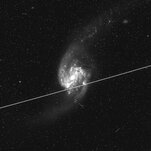
Hubble Telescope Faces Threat From SpaceX and Other Companies’ Satellites
In response, Elon Musk, SpaceX’s founder and chief executive, suggested that astronomers bypass the issue by moving telescopes to orbit.
- Unforgettable Photos: We asked astronomers and others involved in the telescope’s groundbreaking story to tell us about their favorite photos taken over the years.
- 2022 Accomplishments: The space observatory helped scientists determine that a comet they spotted inside Neptune’s orbit was the largest comet ever discovered. It also enabled the discovery of the farthest and earliest star ever seen.
- Comparison With Webb: The James Webb Space Telescope has replaced Hubble as the most powerful space observatory yet built. Here is how the two compare.
- Extending Hubble’s Lifetime: Hubble’s orbit has been slowly dropping over time, which could ultimately lead to its destruction. To avert that prospect, NASA has teamed up with SpaceX.
But Hubble, which lives in low-Earth orbit roughly 335 miles above Earth’s surface, actually resides less than 10 miles below most Starlink satellites. That means that the observatory and other orbital space telescopes are still facing interference from satellite constellations. “Not only do you have to put your telescopes in space, but you also have to put them above all the other traffic,” Dr. McDowell said.
“I think we’ll be forced to do that in the decades to come,” he said. But that isn’t possible for current telescopes in low-Earth orbit or spacecraft that governments are building and launching in the coming years.
To quantify the effect of satellite constellations on Hubble, Sandor Kruk, an astronomer at the Max Planck Institute for Extraterrestrial Physics in Germany, and his colleagues analyzed an archive of images taken from 2002 through 2021.
They had help from hundreds of citizen scientists who pored through images to tag those with clear satellite streaks. That dataset was then used as a training set for a machine-learning algorithm that analyzed more than 100,000 individual Hubble photos. Their results show that the chance of seeing a satellite in a Hubble image from 2009 to 2020 is only 3.7 percent. But the chance of seeing one in 2021 is 5.9 percent — an increase that they say corresponds to Starlink. By the date of the analysis, 1,562 Starlink satellites were in orbit. Another company, OneWeb, had lofted 320 satellites.

